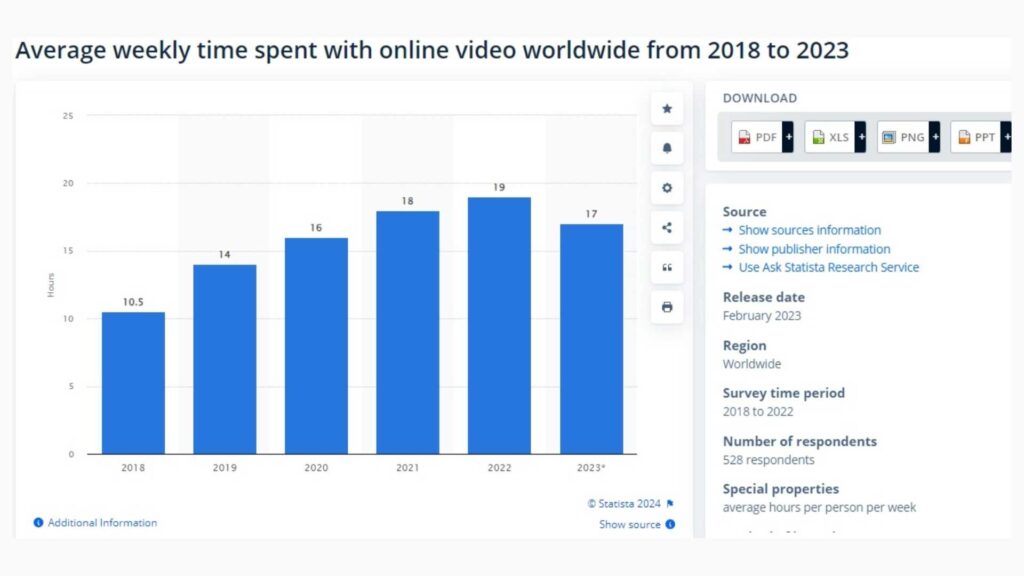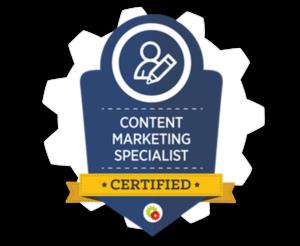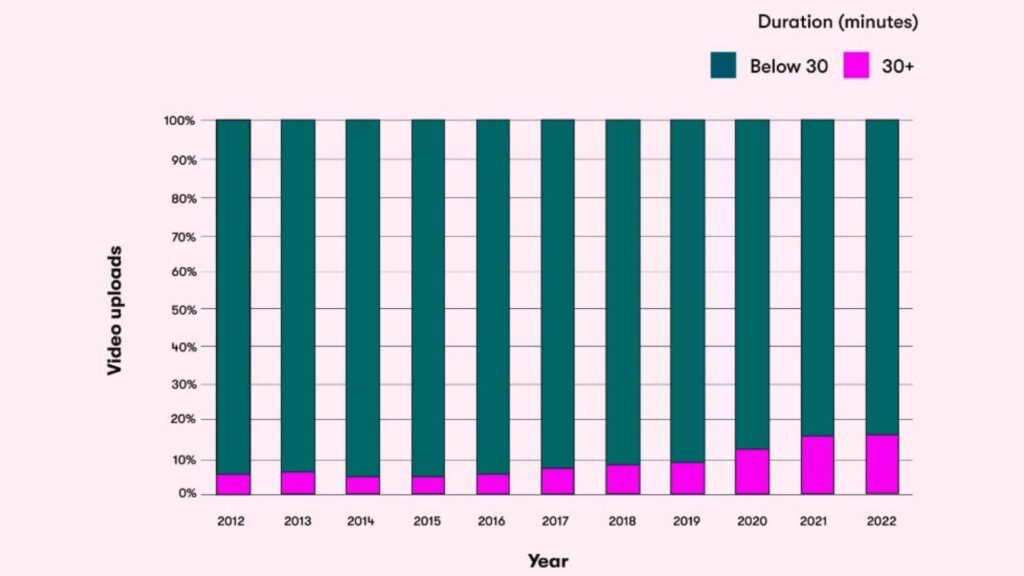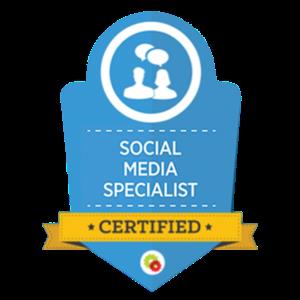
Are you torn between using long-form or short-form videos for your small business marketing campaign? Well, you are not alone. Despite 89% of consumers wanting to see more brand videos, there is no one-size-fits-all answer about the ideal video length.
However, this should not deter you from creating an effective video strategy. In 2023, people watched an average of 17 videos per day, highlighting the influence of video content in today’s digital landscape.

Both short-form and long-form videos offer unique advantages and come with their set of challenges. Join me as I uncover the benefits and limitations of each video format to help you make informed marketing decisions.
What are Short-Form Videos?
Short videos typically range from 30 seconds to less than 10 minutes long. They are popular on social media platforms like TikTok, Instagram, Snapchat, and YouTube.
Short-form videos deliver brief yet engaging messages that quickly capture the viewer’s attention. Here are some popular types of short-form video content.
- TikTok Challenges
- Instagram Reels
- Snapchat Stories
- YouTube Shorts
- Twitter Video Ads
Benefits of Short-Form Videos
A previously cited report shows that 39% of marketers find short-form videos, ranging from 30-60 seconds long, more successful. The same study reports that 44% of customers prefer watching a short video to learn about a brand’s offerings.

So, it is evident that short-form videos have their benefits. Let’s take a closer look at some of them.
Attention-Grabbing
Short-form videos capture attention quickly, making them ideal for the fast-scrolling nature of social media platforms. Your audience is more likely to watch them in their entirety compared to longer content.
Cost-Effective Production
Creating short-form videos requires less time and resources compared to longer videos. As a small business owner with a limited budget, using short-form videos can be cost-effective.
Increased Engagement
Short-form videos engage viewers due to their crisp and concise nature. This results in more likes, comments, and shares that boost your content’s visibility and increase brand awareness.
Integrating short-form videos into your influencer marketing campaigns can further amplify your reach to new and diverse audiences.
Highly Shareable
Short videos are highly shareable. This makes it more likely for your viewers to share them, increasing their virality.

Want to get certified in Content Marketing?
Leverage the tools and channels to predictably and profitably drive awareness, leads, sales, and referrals—EVERYTHING you need to know to become a true master of digital marketing. Click Here
There are multiple benefits of adding video to your website including increased engagement, improved SEO, and enhanced user experience.
Limitations of Short-Form Videos
While short-form videos offer many advantages in content marketing, they also present some challenges.
Limited Message Depth
Due to their brief duration, short-form videos may struggle to convey complex or detailed messages. Longer videos might be more suitable if you need to communicate intricate information.
Competition for Attention
Standing out on platforms flooded with short-form video content can be challenging. You must create content that stands out to avoid becoming lost in the sea of other videos.
Shorter Lifespan
Short videos may lose their relevance with time. They can quickly get buried in users’ feeds, leading to a shorter visibility and engagement period than longer, evergreen content.
This means you must consistently create short-form videos to maintain audience interest over time.
Limited SEO Impact
Short-form videos may be more challenging to optimize for search engines than longer, more keyword-rich content. This can affect the discoverability of your content outside the social media scene.
What are Long-Form Videos?
Long-form videos are typically longer, ranging from a few minutes to several hours. They extend beyond a few minutes to several hours, providing ample time for in-depth topic exploration and detailed content.
These videos are particularly suitable for educational content, product demonstrations, and narrative-driven storytelling. Long-form videos are common on platforms like YouTube and Vimeo. Common types of long-form video content include:
- YouTube Series
- Webinars
- Educational Tutorials and Courses:
- Behind-the-Scenes Content
- Interviews and Conversations
Advantages of Long-Form Videos
Long-form video content is the fastest-growing segment, with videos above 30 minutes experiencing tremendous growth over the years. Let’s explore some of the benefits behind this growth.

Establishes Expertise and Credibility
Long-form videos allow you to provide in-depth information about various subjects, establishing your brand as an authority. Potential customers will likely trust and rely on your insights when you consistently deliver valuable content.
Builds Strong Audience Connections
The more your audience watches your videos, the more they become familiar with your content and brand. This consistent engagement promotes trust and loyalty, helping you create deeper connections with your audience.
Provide SEO Optimization Opportunities
Long-form videos keep your audience engaged for a longer duration than short ones. This signals search engines that your content provides value, resulting in higher rankings and increased visibility.
Besides, these videos provide opportunities to optimize for relevant keywords. This Attrock guide offers more insights into the value of SEO for your small business.
They Are Sustainable
Unlike short videos, well-produced and valuable long-form videos have an extended shelf life. They can continue to attract views and engagement over an extended period, contributing to a sustainable content strategy.
Instagram reels are also a part of short videos and you can get benefits from this platform by integrating it with your website. You can learn how to embed Instagram Reels on websites and get extra benefits from your Reels.
Drawbacks of Long-Form Videos
Despite their benefits, long-form videos also have certain limitations, including:
Attention Span Challenges
Between distractions, juggling tasks, and information overload, user attention span quickly diminishes. Viewers may lose interest and disengage from your long video before its conclusion.

Are You Ready to Master Social Media?
Become a Certified Social Media Specialist and learn the newest strategies (by social platform) to draw organic traffic to your social media sites.
Complex Production Process
Creating high-quality long-form videos requires more resources, including time, equipment, and skilled personnel. This can be disadvantageous, especially for small businesses with limited budgets.
Platform Limitations
Some social media platforms and video hosting sites may limit video length, making it challenging to distribute long-form video content. You may then be forced to repurpose your content to suit various platforms.
Short-Form or Long-Form Videos: Which Are Better?
Now that you know the benefits and limitations of each format, which one should you choose? Short-form or long-form videos?
Well, it all boils down to considering several factors, such as:
Content Objectives
What do you want to achieve from your video marketing campaign? Short-form videos are highly effective for quick brand exposure and generating buzz. Long-form videos, on the other hand, contribute to a more in-depth understanding of the brand.
Target Audience Preferences
Audiences with short attention spans likely prefer short-form videos, while long-form videos appeal to those seeking a more immersive experience.
Similarly, short-form videos may appeal more to younger audiences, while older demographics may prefer the depth of long-form content.
Platform Dynamics
Various platforms support different content formats. Short-form videos are well-suited for platforms like TikTok, Instagram, and Snapchat. On the other hand, platforms like YouTube and Vimeo are better for hosting longer videos.
Industry Type
Short-form videos would be ideal if your industry thrives on trends, entertainment, and quick messages. However, long-form videos are effective for industries requiring in-depth explanations or educational content.
Bottom Line
Ultimately, choosing short-form or long-form videos depends on your business’s specific needs and goals. Since both formats have advantages and limitations, making a choice may prove difficult.
However, it doesn’t have to be an uphill task. The key lies in recognizing when to incorporate each video format into your marketing strategy. Understanding your audience and its needs allows you to combine both formats strategically, maximizing the benefits of each.
Continuously analyze performance metrics and adapt your video marketing strategy accordingly to ensure optimal engagement and conversion rates.
[TAG6]The post Navigating the Video Marketing Maze: Short-Form vs. Long-Form appeared first on DigitalMarketer.
Frequently Asked Questions
What keeps an entrepreneur motivated?
My biggest motivator is the freedom to do whatever I want to achieve my goals. We live in a world with limits on how much money we can earn and save, how much we can invest, purchase, consume, own or borrow. But those limits don't apply to us. We can pursue our dreams, and make them real.
We must not allow these limitations to dictate our lives. If we do that, we lose sight the fact that our destiny is ours. We are the captains for our ships. We are the architects and creators of our lives.
I am motivated by the desire to create wealth beyond all my wildest fantasies. To create businesses bigger than life. To create businesses that transform the lives of people forever.
To create stronger businesses than any governments, more influential as any religion, and longer lasting than time.
This is why I am here. My goal is to help entrepreneurs grow their business faster than anyone else. Because success is for everyone.
How can you motivate yourself to be an entrepreneur?
Finding someone who is motivated to do the same thing as you is the best way to motivate yourself. Ask someone who has worked hard towards achieving his goals to tell you how he did it.
Listen, ask for advice and, most importantly, follow through. Follow the example of someone who is successful.
You can do whatever it takes to be that person. Learn from them. Learn from them. Follow their example.
Keep pushing forward. Keep moving. Never stop learning. Never give up.
Never listen to anyone telling you that you're not capable. You don't have to believe that there is no way.
Even though you may fail, that doesn't make it any less valuable. Failure is an opportunity to grow stronger. To learn more. To push harder.
Failure is just another step along the road to success.
Let's get started! Do something today that will help you get closer to your dream.
Are you still waiting?
Which 6 questions are most motivating for entrepreneurs?
Motivation is the main ingredient of any business. Without motivation, you won't make it out of bed each day. If you lack motivation, it will be difficult to complete your projects. Motivation is essential for reaching your goals. How do we find our inspiration?
You may wonder, "What motivates my mind?" It might surprise you to find out the answer. Perhaps you have been asking this question for years. If you don't ask yourself this question, then you are missing out on one the greatest rewards of your life: the opportunity to discover your motivation.
There's nothing more motivating than discovering why you exist. When you discover what drives you, you can finally feel fulfilled. Your purpose becomes clearer and more meaningful. Why are you caring? This will help you stay motivated.
Looking within is the key to unlocking your motivation. These questions will help you find your motivation.
- What am I passionate about?
- What makes my heart beat faster?
- What lightens me up in my soul?
- What gives me butterflies in the stomach?
- What makes you feel alive to me?
- What makes you come back to your project again and again?
Once you know the answers to your questions, you will be able identify your true motivations.
You can find your motivation to get through tough times. It will give strength when you need. It will make you work harder. You will be motivated to achieve your goals.
And if your like me, then you'll never stop trying to find out what your motivations are.
Spend some time today reflecting on your motivations. You might be surprised at your discoveries.
What are the rewards of being an entrepreneur?
Being an entrepreneur has many benefits. First, you can become independent. You stop relying solely on other people.
You are free to pursue your goals and become independent. You can also build relationships with other entrepreneurs, as you share the same challenges and interests.
You gain confidence. You're constantly learning new things as an entrepreneur. This allows you to be flexible and adapt quickly. Thinking outside the box means you won't get stuck in a rut.
Everybody can start their business without being bound by any rules or regulations. We have the freedom to decide what and how to live our lives.
We can choose to follow the crowd or go against it. We have the option to choose success or failure. We can choose to fail or win.
The freedom you have is exhilarating. You also have to take responsibility. Because once you step into this role, you're accountable for everything that happens within your business.
To succeed, you have to learn to manage risks. Try new things. You will eventually achieve your goal if you are willing to learn from your mistakes.
So, keep these lessons in mind when starting your journey.
Remember:
- Entrepreneurship is a lifestyle choice.
- When you run your own business, you're the boss.
- Be cautious about following the trends.
- The measure of success is not money, but freedom.
- You must balance your personal and work life.
- Set clear expectations.
- Be honest with your team.
- Be persistent if it's your desire for something to happen.
What motivations are there for entrepreneurs?
There are three main types of motivation for entrepreneurs. Each type of motivation has its strengths and weaknesses.
External motivation is the most prevalent form of motivation. An individual wants more money. This motivation comes from financial concerns.
Motivation is externally driven by personal ambition, desire, and interest. These types of motivation are very goal-oriented.
This is a rare form of motivation. Internal motivation is far more rare than wealth. Individuals with it do not seek to be wealthy. Instead, these individuals pursue other goals, like self-development, fulfillment and service.
People with internal motivation are frequently called "passionate" since they find satisfaction from their work.
The last type of motivation that is most common is intrinsic motivation. Intrinsic motivation refers to individuals who derive enjoyment and satisfaction from working toward a particular goal.
Internal motivation is much more motivating than external or intrinsic motivation.
Inner motivation is a result of the inner self. It is based the belief people are endowed with certain talents and capabilities. These talents and abilities enable them to achieve feats that no other person could ever do.
When we realize our talents and abilities, we feel satisfied and fulfilled. We feel important.
In simple words, intrinsic motivation makes us feel happy. Knowing that we can achieve anything we set our minds too is what makes us happy.
This feeling of accomplishment is what keeps us going through tough times.
In fact, if you don't enjoy what you're doing, then why bother doing it at all?
Click here to find out more about entrepreneurial motivation.
What makes an entrepreneur a success?
There are two types: those who make money and those that make time.
The difference between them is how they approach their business. Money-makers focus on making more while time-makers focus on making more.
Money-makers are driven by financial freedom. Their goal: to be wealthy and stay rich.
They are motivated by fear and greed. They are motivated by fear and greed, but they don't think about the long-term.
This type of person is commonly referred to by the term "hustler". They focus on the bottom line and find ways to increase revenue without regard to quality.
Some people have the ability to make it work. These entrepreneurs are driven to succeed by their passion. They desire to create something meaningful and lasting.
Their motivation is altruistic. They want to accomplish great things. They want to create products and services that are meaningful.
These people are known as dreamers. They are driven by inspiration and vision. They know success requires perseverance, hard work and dedication.
However, the most important quality of these entrepreneurs? They are creative. They are always on the lookout for opportunities that aren't available before.
They thrive in the unknown. They are happy to spend hours researching a topic of interest. They are always open to learning new things because they love learning.
They are able to adapt to changes easily. They will take on any challenge and get dirty. They will not tolerate mediocrity.
What type of entrepreneur would you be? Are you driven to make it big or do you want to find meaning in life?
Congratulations if you answered both questions. You are a successful entrepreneur.
I've met many successful entrepreneurs over the years and noticed one common trait among them: they were driven by passion.
The only thing that defines successful entrepreneurs is their financial wealth. The impact defines them they leave behind.
Steve Jobs was a great example of philanthropic work, even though he wasn’t wealthy. He didn't own a house until his mid-40s.
His ability to make products that made a difference in the world is what brought him wealth. And this is what makes him unique.
Your job doesn't involve accumulating wealth. It's not to build empires or amass power.
Your job is to establish relationships with customers, partners, and other people. To build trust. To inspire others to succeed.
To make a positive impact. Your legacy. Not your bank account.
If you are interested in building a legacy that is meaningful, let's get started.
Here at Social Media University, we'll show you how to earn passive income online. We'll show you how to market your company so that it grows automatically.
Statistics
- Invest at least 30% managing those with authority over you and 15% managing your peers.” (americanexpress.com)
- "Most of the time when people ask me about motivation, 80 percent of the time, I attribute it to gratitude. (entrepreneur.com)
- "If you improve by just 1% every single day, in several months, you will have improved by 100%. (carolroth.com)
- That means for $150,000, you could have bought 10 percent of Airbnb." (entrepreneur.com)
- “Effective communication is 20% what you know and 80% how you feel about what you know. (americanexpress.com)
External Links
[TAG30]
[TAG32]
[TAG35]
- How to Get Over Your Fear of Failure - Due
- 7 Daily Habits That Make People Extremely Productive - Due
[TAG38]
How To
How do I sustain my motivation when starting a business?
It is essential to create an income stream in order to make money online. This means creating a method to consistently generate revenue through your website.
It is easy to solve customers' problems by creating products. How can you create these products, though? That's where the real fun begins.
There are two ways to approach product creation. The first is to think of a great idea. After that, you spend hours perfecting it. This is the traditional way.
There is another way. Another option is to ask yourself "What problem am i trying to solve?" Find the right product to solve that problem.
This is known as the "find-a problem" method. The find-a-problem technique will likely reveal a problem that isn’t being solved at any other site.
Once you find the problem you need to solve, you can decide whether you want to do so. The following questions will help you answer the most basic of these questions:
- Is it worthwhile?
- What can you do to fix it?
- Is it worth it?
If you can answer the three questions correctly, you have the basis for a great product. The next step is to determine how to package it.
Most businesses fail because they lack a plan for generating recurring revenue. It's easier to stay focused once you have your plan.
Sometimes you may find yourself with more ideas than time to put them all into practice. In this instance, you could delegate tasks to members of your team or hire freelancers.
As long as you continue to grow your income stream, you'll be able to stay motivated.
Remember: You can do almost anything if you are willing to work hard. Don't wait! Get started now!






